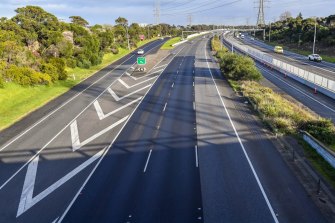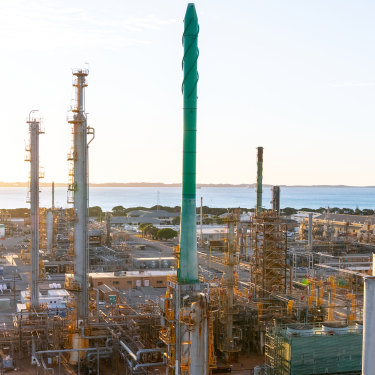Running on empty: Oil refineries at breaking point as world grinds to a halt

From the dawn of the lockdowns, Australia’s biggest cities virtually shuddered to a stop. Busy streets were all but deserted, the roar of traffic dulled to a whisper.
Few scenes drove home the scale of the disruption more than silent freeways and empty skies, so the fuel slump that followed was destined to be severe. Petrol usage in the June quarter fell 26 per cent. Aviation fuel crashed 80 per cent.
It’s been a temporary breath of fresh air for the environment, with transport emissions down sharply as a result. But for Australia’s oil refineries – plants that process crude oil into fuel products – this is a moment of reckoning. The deepest and fastest demand crash in decades is reverberating through the industry, pushing oil refineries to financial breaking point. One has already announced it is closing down for good – BP’s Perth refinery, the country’s largest. The three that are left are at risk of closing too. Thousands of well-paid jobs are hanging in the balance.
“We are losing one refinery. We do not want to lose a second or a third,” says Ben Davis, Victorian branch secretary of the Australian Workers Union. “The announcement at BP … sent a shudder down our collective spines.”

Across the nation, mobility restrictions are gradually easing and cars are returning to roads, even in the worst-hit state of Victoria where a hard, second-wave lockdown lasted 111 days. But the crisis for oil refineries is far from over.
The three plants remaining – Viva Energy’s Geelong refinery, ExxonMobil’s in Altona and Ampol in Brisbane – have all dramatically slowed their fuel output in the face of severe oversupply. All three are bleeding multimillion-dollar losses, with their refining margins under enormous strain. Viva Energy, for instance, reported a third-quarter margin of $US2.30 a barrel, down from $US2.90 in the first half and $US6.60 a barrel on average in 2019.
While some petrol demand is returning, it is tipped to stay below pre-pandemic levels for much of the foreseeable future. Jet fuel, meanwhile, is recovering far slower than previously expected as planes remain grounded and borders shut. And there is a growing realisation across the industry that less air travel could be here to stay.
Viva is conducting a review of its 65-year-old Geelong refinery, weighing options including its permanent closure, after losses spiralled to nearly $80 million. At the Brisbane refinery, the situation is even worse, with losses blowing out to $141 million. Ampol has told investors it is also considering closing down its Brisbane refinery and converting the site into a fuel-import terminal.
“Frankly, it’s a very challenged industry, full-stop,” says Mark Samter, an energy analyst with MST Marquee.
“These are not idle threats by companies … These are wildly, wildly unsustainable numbers. if you leave these to the free markets, none of them survives.”
The pressure on oil refiners is being felt around the world, but Australia’s plants are considered at an even greater risk, Samter explains, because facilities here are much smaller and the costs to run them generally far higher. Three Australian oil refineries have closed in the past decade, as the local sector’s dwindling fleet of ageing, smaller facilities has proved unable to compete with newer, cheaper mega-refineries being built in Asia.
Combined, Australia’s three remaining refineries have a capacity of about 300,000 barrels a day. Compare that with Asia’s largest refinery, which can churn out 1.2 million barrels.
But the coronavirus-driven downturn has landed at a decidedly difficult time, slashing earnings just as Viva and Ampol had to give the go-ahead to significant maintenance investments in their refineries, known as turnarounds, which are needed every few years in order to continue operating. It also comes as the companies are forced to consider their longer-term future of refining here ahead of the looming introduction of new Australian sulfur emissions standards for petrol, which are presently among the worst in the OECD. Ahead of a 2027 deadline, refineries will need to begin undertaking highly capital-intensive technical upgrades to their equipment to comply with the new standards.
“Fundamentally it’s a big cap-ex bill, about $250 million per refinery,” Samter says. “And there’s no benefit for them on the other side. It’s just to be able to produce the new-spec product.”
The significance of a country’s ability to continue making its own transport fuels, and the desire to keep its sizeable manufacturing workforce employed, has not been lost on legislators.
The Morrison government has been leading discussions with refiners for months, working to develop a rescue package including a 1.15¢-a-litre payment for locally made fuel in a bid to keep refineries open “wherever commercial possible”. The federal budget also contained measures to buffer Australia against potential supply shocks caused by global events such as wars or pandemics, including a $200 million-plus investment in a competitive grants program to develop new onshore diesel storage and increase stocks by 40 per cent.
‘These are not idle threats by companies … These are wildly, wildly unsustainable numbers. if you leave these to the free markets, none of them survives.’
Mark Samter, energy analyst with MST Marquee
In Victoria, the Andrews government is mulling ways to support the state’s two refineries, and is in talks over a potential co-investment in an expansion of the Geelong site, according to government and industry sources, who asked not to be identified as the discussions were confidential. The proposal is to expand the 65-year-old refinery site into an energy hub with LNG import capability alongside refining.
However, Greg Bourne, global oil major BP’s former Australasian president and now a member of the Climate Council, says the government argument that local refineries must be kept to ensure the nation’s fuel independence is a spurious one.
As Bourne says, Australia’s domestic crude oil production from fields in the Bass Strait and elsewhere has been in rapid decline, meaning local refineries rely heavily on imports of crude oil to process petrol, diesel and jet fuel. This, he says, raises an obvious question. More and more overseas refineries are producing Australian-specification fuel products, which can be shunted around the world and imported to Australia just as easily as crude. So why are local oil refineries needed at all? The companies themselves know this, says Bourne and, increasingly, are mulling turning their sites into fuel-import terminals instead.
“A product tanker is a product tanker,” he says. “There is no need to have a refinery base anymore. Our refineries, almost logically, eventually turn into terminals.”
In the years and decades ahead, as the shift to clean energy and the rise of electric vehicles eat further into demand for emission-intensive fuels, the new terminal facilities could be used to import aviation biofuels, Bourne suggests. (The International Energy Agency projects biofuels will supply about 10 per cent of aviation fuel demand by 2030 and close to 20 per cent by 2040). The terminal infrastructure could also be repurposed to store and export Australian-made green-energy exports such as hydrogen in the future.
Federal governments, both Labor and Liberal, have neglected to uphold Australia’s obligation as a member of the International Energy Agency to have 90 days of oil reserves to protect against the event of a severe supply disruption. Australia’s reserves currently stand at 65 days, the lowest of any member country. But for oil refiners, union leaders and industry analysts, Prime Minister Scott Morrison’s proposed rescue package is a clear signal leaving no doubt that it values fuel security and believes in the benefits of retaining local refining sector in some capacity.
Angus Taylor, the federal Energy Minister, says maintaining local oil refining capability offers Australia significant fuel-security benefits and must not be overlooked. “Stockholding plays a role and will continue to play a role, but refining has the added advantage of much longer-term fuel security in the worst possible scenarios,” he tells The Age and The Sydney Morning Herald.
Union representatives for refining workers agree. “Australia’s capacity to make its own fuel cuts to the heart of our viability as a sovereign nation,” AWU national secretary Daniel Walton said following BP’s closure. “If we can’t independently fuel our trucks, our farmers, and our defence industry then we leave ourselves incredibly vulnerable.”
The biggest concern inside the industry now is when the support package will start being delivered. “Timing is of the essence,” says Samter, as it has become plainly clear the initially proposed six-month time-frame may be too long to avoid plant closures and job losses.
While the discussions are continuing, the federal government and refiners are working towards rolling out the production payment early in the new year. “We are committed to fuel security, doing everything we can to protect those important jobs,” says Taylor.
“We know how challenging a time it is for the refineries. We understand the urgency.”
Market Recap
A concise wrap of the day on the markets, breaking business news and expert opinion delivered to your inbox each afternoon. Sign up for the Herald‘s here and The Age‘s here.
Business reporter for The Age and Sydney Morning Herald.
Most Viewed in Business
Source: Thanks smh.com